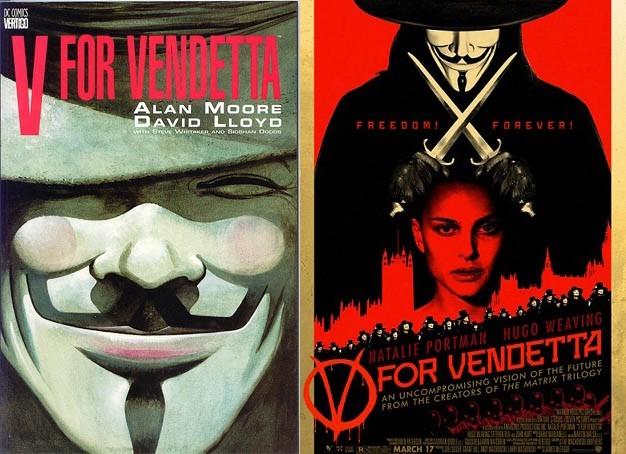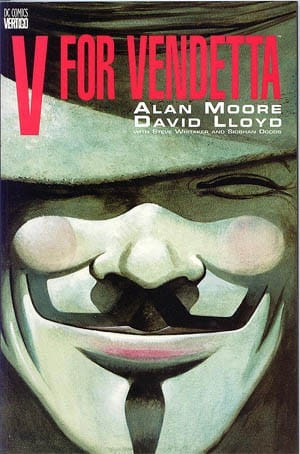The popularity of “V for Vendetta”, originated in the graphic novel written by Alan Moore and illustrated mainly by David Lloyd, and later amplified by the movie directed by James McTeigue, finds its roots in the year 1604 thanks to an individual named Guy Fawkes.
 On the left: “V for Vendetta”, comic book by Alan Moore and David Lloyd. Right: “V for Vendetta”, film by James McTeigue.
On the left: “V for Vendetta”, comic book by Alan Moore and David Lloyd. Right: “V for Vendetta”, film by James McTeigue.
Guy Fawkes
 1570 – 1606
1570 – 1606
Guy Fawkes was one of many recusants in England in the 16th and 17th centuries. A staunch defender of the Catholic religion, he faced persecution after the establishment of the Anglican Church during the Protestant Reformation.
Unlike other recusants, Guy Fawkes, along with other provincial Catholics, took the fight for Catholicism to the extreme. His commitment made him the driving force behind the “Gunpowder Plot,” an intricate two-year plot to eliminate King James I and much of the Protestant aristocracy. This elite had relegated the religion of Catesby and Fawkes to a minority and persecuted position.
In 1605, the conspiratorial group grew to 13 members with a seemingly simple goal: to rent space under Parliament to gradually store gunpowder until it accumulated 36 barrels. The plan was to detonate it when Parliament met, eliminating those who permitted Catholic repression. However, a letter warned a Catholic parliamentarian days before the opening, arousing suspicion. As a precaution, on November 4, 1605, the eve of the opening of Parliament, a raid was carried out that discovered Guy Fawkes preparing the attack.
Subjected to torture, he confessed the names of the conspirators, many of whom were executed for treason in the very place they intended to destroy. On January 31, 1606, the English government sold tickets for the execution of the traitors. All were hanged, castrated, burned alive, eviscerated and beheaded.
This grim episode went down in history as a day of celebration in England, remembering the execution of traitors and recreating Guy Fawkes in a mask.
“V for Vendetta”
 “V for Vendetta”, comic book by Alan Moore and David Lloyd, published by Vertigo-DC Comics
“V for Vendetta”, comic book by Alan Moore and David Lloyd, published by Vertigo-DC Comics
Were it not for Alan Moore’s adaptation in “V for Vendetta,” Guy Fawkes might have been relegated to the original story. The graphic novel is set in an England devastated by a nuclear war, now under a fascist government. Against this regime arises the image of an anarchist avenger, taking up the anti-totalitarian representation of Guy Fawkes and his mask, leaving aside the religious connotations.
The film seeks to capture the plot of the graphic novel, although Alan Moore himself did not agree with certain aspects of the script, demanding that his name be removed from the credits. In contrast, illustrator David Lloyd supported the adaptation and appears in the credits.
Anonymous
 Motto: “Knowledge is free. We are Anonymous. We are Legion. We do not forgive. We do not forget. Expect us!”.
Motto: “Knowledge is free. We are Anonymous. We are Legion. We do not forgive. We do not forget. Expect us!”.
The mask that many protesters wear has become a symbol of struggle against what they consider an oppressive state. Today, an activist group has emerged as an internet phenomenon: a virtual community with a voluntary goal of hacktivism as a form of protest.
La popularidad de “V for Vendetta”, originada en la novela gráfica escrita por Alan Moore e ilustrada principalmente por David Lloyd, y posteriormente amplificada por la película dirigida por James McTeigue, encuentra sus raíces en el año 1604 gracias a un individuo llamado Guy Fawkes.
 A la izquierda: “V for Vendetta”, cómic de Alan Moore y David Lloyd. A la derecha: “V for Vendetta”, película de James McTeigue
A la izquierda: “V for Vendetta”, cómic de Alan Moore y David Lloyd. A la derecha: “V for Vendetta”, película de James McTeigue
Guy Fawkes
 1570 – 1606
1570 – 1606
Guy Fawkes fue uno entre muchos recusantes de Inglaterra en los siglos XVI y XVII. Fiel defensor de la religión católica, enfrentó persecución tras el establecimiento de la Iglesia Anglicana durante la reforma protestante.
A diferencia de otros recusantes, Guy Fawkes, junto con otros católicos provinciales, llevó la lucha por el catolicismo al extremo. Su compromiso lo convirtió en el motor de la “Conspiración de la Pólvora”, un intrincado complot desarrollado durante dos años con el propósito de eliminar al rey Jacobo I y a gran parte de la aristocracia protestante. Esta élite había relegado la religión de Catesby y Fawkes a una posición minoritaria y perseguida.
En 1605, el grupo conspirador creció a 13 miembros con un objetivo aparentemente simple: alquilar un espacio bajo el Parlamento para almacenar gradualmente pólvora hasta acumular 36 barriles. El plan consistía en detonarla cuando el Parlamento se reuniera, eliminando a quienes permitían la represión católica. Sin embargo, una carta advirtió a un parlamentario católico días antes de la apertura, suscitando sospechas. Por precaución, el 4 de noviembre de 1605, la víspera de la apertura del Parlamento, se realizó una redada que descubrió a Guy Fawkes preparando el atentado.
Sometido a tortura, confesó los nombres de los conspiradores, muchos de los cuales fueron ejecutados por traición en el mismo lugar que pretendían destruir. El 31 de enero de 1606, el gobierno inglés vendió entradas para el ajusticiamiento de los traidores. Todos fueron ahorcados, castrados, quemados vivos, eviscerados y decapitados.
Este sombrío episodio pasó a la historia como un día de celebración en Inglaterra, recordando la ejecución de los traidores y recreando a Guy Fawkes con una máscara.
“V for Vendetta”
 “V for Vendetta”, cómic de Alan Moore y David Lloyd, publicado por Vertigo-DC Comics
“V for Vendetta”, cómic de Alan Moore y David Lloyd, publicado por Vertigo-DC Comics
Si no fuera por la adaptación de Alan Moore en “V de Vendetta”, Guy Fawkes podría haber quedado relegado a la historia original. La novela gráfica está ambientada en una Inglaterra devastada por una guerra nuclear, ahora bajo un gobierno fascista. Contra este régimen surge la imagen de un vengador anarquista, retomando la representación antitotalitaria de Guy Fawkes y su máscara, dejando de lado las connotaciones religiosas.
La película busca plasmar la trama de la novela gráfica, aunque el mismo Alan Moore no estuvo de acuerdo con ciertos aspectos del guion, exigiendo que su nombre fuera retirado de los créditos. En contraste, el ilustrador David Lloyd respaldó la adaptación y figura en los créditos.
Anonymous
 Lema: “Knowledge is free. We are Anonymous. We are Legion. We do not forgive. We do not forget. Expect us!”. Traducción: “El conocimiento es libre. Somos Anónimos. Somos Legión. No perdonamos. No olvidamos. ¡Espéranos!”
Lema: “Knowledge is free. We are Anonymous. We are Legion. We do not forgive. We do not forget. Expect us!”. Traducción: “El conocimiento es libre. Somos Anónimos. Somos Legión. No perdonamos. No olvidamos. ¡Espéranos!”
La máscara que muchos manifestantes usan se ha convertido en un símbolo de lucha contra lo que consideran un estado opresor. En la actualidad, un activista grupo ha emergido como un fenómeno de internet: una comunidad virtual con un objetivo voluntario de hacktivismo como forma de protesta.